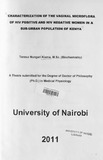| dc.description.abstract | The vaginal microflora is dynamic and changes occur in the course of the menstrual cycle. Lactobacilli are the dominant species of vaginal microflora (VMF) in healthy women and play an important role in the maintenance of vaginal health. When lactobacilli are depleted due to antibiotic use, douching or sexual practices, other aerobic and anaerobic organisms take over, which leads to a condition known as bacterial vaginosis (BV). BV has been shown to increase the risk for the acquisition of HIV in women in sub-Saharan Africa where heterosexual transmission is the major route of infection. There is still need for more studies to fully characterize the vaginal microflora and changes occurring during the menstrual cycle. The main purpose of this study was to characterize the vaginal microflora during the menstrual cycle of HIV positive (HIV+ve) and HIV negative (HIV-ve) women with normal cervicovaginal physiology in a sub-urban population in Kenya.
Methods
Women of 18-45 years in general good health, with a regular menstrual cycle and willing and mentally competent to give informed consent were recruited in the study. Exclusion criteria were use of hormonal contraceptives, presence of sexually transmitted infections other than HIV, use of antiretroviral therapy, a CD4 count below 250 cell/μl blood, pregnancy, recent delivery or abortion and previous hysterectomy or conisation.
In this descriptive comparative study 100 women (50% HIV+ve) were followed up. Of these, 74 (41 HIV+ve and 33 HIV-ve) completed the two consecutive menstrual cycle follow-up and had high vaginal swabs taken for gram stain and anaerobic culture. Sampling was done at three time points during the cycle as follows: follicular phase (days 5-8); ovulatory phase (days 12-15); luteal phase (days 19-22). Gram stains were prepared for a total of six visits for each participant whereas anaerobic cultures were performed for a total of four visits
per subject. The isolates were identified to species level by means of t-DNA PCR. For 38 women (20 HIV+ve and 18 HIV-ve) high vaginal swabs were taken for DNA extraction and quantification by real time PCR of three Lactobacillus spp. (L. crispatus, L. jensenii and L. iners) and Gardnerella vaginalis and Atopobium vaginae.
Results
Bacterial vaginosis was diagnosed at 17.5% of enrolment visits. Respectively 42.4% of HIV-ve and 31.7% of HIV+ve women harboured a normal vaginal microflora on all six visits. In 45% of both groups, at least two BV or intermediate episodes were observed. A total of 751 cultured isolates were identified belonging to 51 species. Of these, nine belonged to the genus Lactobacillus. In decreasing order the most common lactobacilli were L. crispatus, L. iners, L. jensenii and L. vaginalis. While 54% of HIV-ve and 60% of HIV+ve women were colonized by lactobacilli on at least one visit, respectively only 9% and 29% had lactobacilli on at least three visits.
The following species were cultured more frequently in HIV+ve women: Lactobacillus jensenii (p=0.01), L. iners (p=0.02), Gardnerella vaginalis (p=0.01) and Peptoniphilus lacrimalis (p=0.01); whereas these two species occurred more frequent in HIV-ve women: Dialister micraerophilus (p=0.02) and Streptococcus agalactiae (p=0.04).
Real time PCR results show a high load of L. iners in the normal vaginal microflora and high levels of L. jensenii in half of the women with bacterial vaginosis. Both groups had a high concentration of L. iners and G. vaginalis. Although condom use was significantly higher in HIV+ve women, the number of women harboring the protective L. crispatus and the concentration of L. crispatus was remarkably lower compared to HIV-ve women.
Results based on Gram stain category show a high load of L. iners in the normal vaginal microflora and which increases during BV. There were high levels of L. jensenii in half of the women with BV while L. crispatus was absent in BV cases. G. vaginalis concentration increased progressively from normal to BV microflora while A. vaginae was absent in normal microflora but was detectable in intermediate gram stain and increased progressively during the BV phase.
Analysis of PCR results based on HIV status showed a high concentration of L. iners and G. vaginalis in both the HIV+ve and HIV-ve groups. A.vaginae was present in both groups but L. jensenii was not detectable in the HIV+ve women.
Analysis based on phase of menstrual cycle showed a high concentration of L. iners and G. vaginalis throughout the menstrual cycle. Concentration of L. crispatus increased while concentration of A. vaginae decreased throughout the menstrual cycle. L. jensenii was not detectable after the initial phase of the menstrual cycle where it was comparatively low.
Conclusions
The rate of BV was found to be equally high in both HIV+ve and HIV-ve women. Frequent fluctuations were observed in half of the women and the numbers of normal, intermediate and BV episodes were evenly spread out in the three sampling points. Minor differences in the species composition of the vaginal microflora of HIV+ve and HIV-ve women were found. L. crispatus, L. iners, L. jensenii and L. vaginalis were the predominant lactobacilli in culture. Overall the frequency of lactobacilli present in these Kenyan women was less than previously observed in similar studies of Caucasian women. L. crispatus, which is the predominant species in normal vaginal microflora in Caucasian women, was very low in this Kenyan study population. L. iners was present in high concentration in the normal vaginal microflora and increased during BV. | en_US |

